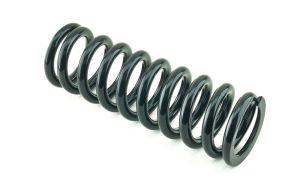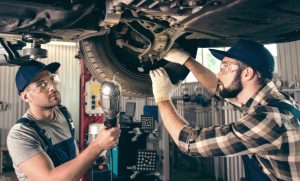When it comes to off-road driving, few systems are as critical as the suspension. It’s what keeps your tires in contact with uneven terrain, absorbs impacts from rocks and bumps, and provides stability over unpredictable surfaces. At the heart of every suspension system are the springs — components that determine how a vehicle handles obstacles, distributes loads, and maintains traction. Understanding how suspension springs work and how their characteristics influence off-road performance can help you choose the right setup for your adventures.
Understanding Suspension Springs

Suspension springs are designed to store and release energy as the wheels move over bumps and dips. They support the vehicle’s weight while allowing controlled movement of the suspension. In off-road conditions, springs are constantly compressed and extended, so their design, stiffness, and material properties play a huge role in performance and comfort.
There are three main types of springs used in off-road vehicles:
| Spring Type | Characteristics | Common Usage |
|---|---|---|
| Coil Springs | Compact, linear or progressive rate, easy to tune | SUVs, pickup trucks, performance 4x4s |
| Leaf Springs | Durable, excellent load-carrying ability, less articulation | Heavy-duty trucks, utility vehicles |
| Torsion Bars | Adjustable preload, compact design | Independent front suspensions (IFS), crossovers |
Each spring type affects ride height, comfort, and handling in different ways — making spring selection a key factor in off-road tuning.
Key Functions of Suspension Springs Off-Road
Off-road suspension systems are not just about absorbing shocks; they need to handle extreme conditions where the terrain changes rapidly. Here are the primary functions that springs perform in such environments:
-
Maintaining Tire Contact – Springs help keep the tires planted even over rocks, ruts, and inclines, ensuring traction and control.
-
Energy Absorption and Damping Support – They work alongside shock absorbers to absorb impact forces and stabilize the chassis.
-
Ride Height and Ground Clearance – Stiffer or longer springs can increase clearance, helping avoid underbody damage.
-
Weight Distribution – Properly tuned springs ensure even load distribution, improving balance and handling.
-
Articulation and Flexibility – Softer or progressive-rate springs allow the wheels to move independently, maximizing grip on uneven ground.
Spring Rate and Its Impact on Off-Road Behavior
Spring rate — measured in force per unit of compression (e.g., N/mm or lb/in) — defines how much force is required to compress a spring. The right spring rate is essential for balancing comfort, stability, and traction.
| Spring Rate Type | Advantages | Disadvantages |
|---|---|---|
| Soft Spring Rate | Better articulation and comfort; improved traction on uneven surfaces | Increased body roll, less stability at high speeds |
| Stiff Spring Rate | More control and load capacity; improved handling on firm ground | Reduced comfort, less wheel travel over obstacles |
| Progressive Rate | Best of both worlds: soft initial response with increasing stiffness under load | More complex to manufacture; costlier |
A vehicle with overly stiff springs may bounce or lose contact on rough terrain, while too-soft springs can bottom out and reduce control. Ideally, off-road setups use progressive or dual-rate springs to balance comfort with capability.
Spring Materials and Durability
Off-road conditions expose suspension components to mud, moisture, debris, and extreme loads. Therefore, material quality and surface treatment are critical.
Common materials:
-
High-tensile steel: The most common choice — durable and cost-effective.
-
Chromium-silicon alloys: Enhanced fatigue resistance for performance applications.
-
Titanium: Lightweight, corrosion-resistant, and strong, but significantly more expensive.
Springs are often powder-coated or zinc-plated to resist corrosion. When choosing replacements, ensure the material and coating are suitable for your driving environment — especially if you drive in wet, muddy, or salty regions.
Matching Springs with Shocks
Springs and shock absorbers (dampers) work together. Springs handle load-bearing and motion, while shocks control motion speed and prevent excessive bouncing. If you upgrade one without the other, the system may become unbalanced.
Ideal pairing tips:
-
Use stiffer shocks with higher-rate springs for performance or heavy-duty setups.
-
For comfort-oriented off-roading, match softer springs with moderately valved shocks.
-
Always replace springs in pairs (left and right) to maintain symmetry and stability.
Lift Kits and Spring Upgrades
Many off-roaders install lift kits to gain extra clearance for larger tires and better obstacle approach angles. These kits often include longer or stiffer springs, depending on the vehicle and desired lift height.
Types of Lift Springs:
-
Spacer lifts: Simple and inexpensive, but don’t improve spring performance.
-
Replacement coil lifts: Designed to improve both height and suspension travel.
-
Heavy-duty or variable-rate springs: Ideal for vehicles carrying additional gear or armor.
When upgrading, ensure the lift height matches your drivetrain and steering geometry to avoid excessive wear or alignment issues.
Choosing the Right Springs for Your Off-Road Needs
Before selecting new suspension springs, consider your vehicle type, load requirements, and terrain.
Checklist for choosing off-road springs:
-
Determine your typical load (gear, passengers, accessories).
-
Identify terrain type: rocky, muddy, desert, or mixed.
-
Choose a spring rate that balances comfort and control.
-
Verify compatibility with existing shocks and mounts.
-
Consider corrosion protection for harsh environments.
If you’re ready to upgrade, you can Buy Springs & Components online — a convenient way to find high-quality options tailored to your vehicle’s specifications and driving conditions.
Common Signs of Worn or Weak Springs

Even the toughest springs wear out over time due to fatigue, corrosion, or overloading. Here are signs it may be time for replacement:
-
Sagging ride height on one side
-
Uneven tire wear
-
Clunking or creaking noises when driving over bumps
-
Reduced ground clearance
-
Poor handling or bottoming out on obstacles
Replacing worn springs restores ride height, stability, and performance — especially crucial for off-road vehicles that operate in demanding environments.
Comparison Table: Off-Road Spring Performance
| Feature | Soft Springs | Stiff Springs | Progressive Springs |
|---|---|---|---|
| Ride Comfort | Excellent | Fair | Very good |
| Load Capacity | Low | High | Medium to high |
| Handling Precision | Moderate | Excellent | Very good |
| Wheel Articulation | High | Moderate | High |
| Off-Road Versatility | Good | Limited | Excellent |
| Ideal For | Light off-roading, overlanding | Heavy loads, fast terrain | Mixed terrain, performance use |
Conclusion
Suspension springs are far more than metal coils supporting your vehicle — they define how effectively your 4×4 conquers terrain, maintains stability, and protects you from harsh impacts. Whether you’re crawling over rocks or navigating forest trails, choosing the right springs ensures balanced performance, comfort, and control.
By understanding spring types, rates, and materials, you can make informed upgrades that suit your off-road style and demands. And when it’s time to replace or enhance your setup, you can easily Buy Springs & Components online to restore — or even improve — your vehicle’s off-road performance.